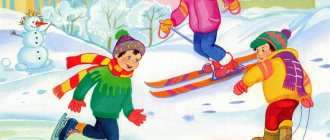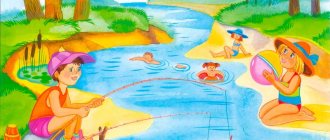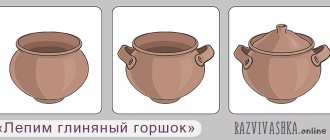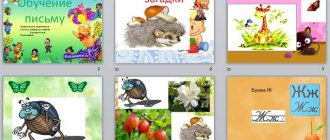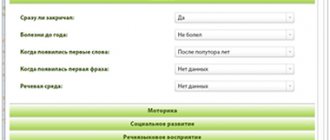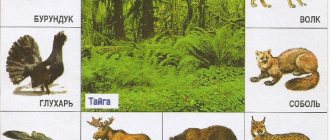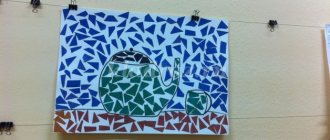Compiling a story based on a series of plot pictures develops speech, logic, thinking, observation, enriches vocabulary and provokes a serious thought process.
One of the basic aspects of preparing a child for school is the formation of coherent, understandable, logical speech in a preschooler.
Monologue speech is especially important in preparation for school, because preschoolers mainly use dialogues.
Compiling a story based on a series of cut-out plot pictures seems, although more complex, but much more interesting task for preschoolers than telling a story based on one static picture. In the case of a series of pictures, you can use a larger number of different verbs in different tenses, more descriptive phrases.
Such pictures also have a positive effect on logical thinking : after all, you need to establish the correct sequence of actions.
Fine motor skills are also involved : cutting pictures.
Compiling a story based on a series of pictures “Seasons”
These illustrations are more difficult for composing a story, since the story itself will be more descriptive: fewer verbs, more adjectives.
Note: the author of the illustrations is unknown, taken from open sources. If you know the artist, please post in the comments or via the Contact page so credit can be given!
Retelling fairy tales based on reference pictures
Thematic pictures for composing a story for preschoolers based on fairy tales and seasons. Helpful pictures for retelling fairy tales: Kolobok, Turnip, Teremok.
Seasons
Stories in pictures
Having previously cut the pictures along the dotted lines, invite the child to lay out the pictures sequentially and make up a story based on them.
The game promotes the development of imagination, coherent speech, logical thinking, observation and attention.
Advantages and disadvantages of the technique
Like any other tool for assessing the level of development, the “sequential pictures” technique has its advantages and disadvantages. Its undoubted advantages are as follows:
- Ease of implementation. Finding a series of pictures on the Internet and printing it is not difficult for either teachers or parents. It's easy to select the desired difficulty level. Any mother can evaluate the quality of work, at least approximately.
- Demonstration. The test helps not only to assess the intellectual capabilities of a healthy child, but also to identify possible delays in mental development. If by the age of 6 the child finds it difficult to describe pictures even with the help of leading questions, this is a signal for parents that they need to consult a specialist.
- Developmental effect. In itself, completing such tasks is very useful for preschoolers starting from 4 years old. Games based on the analysis of sequential pictures train the same abilities that the test evaluates - logic and speech.
The disadvantages of testing are mainly related to the human factor, both on the part of the test subject and on the part of the inspection commission:
- Distortion of the result due to the individual characteristics of the child. By the age of 6–7 years, the personality of a preschooler has already largely developed - everyone has their own character. Some people willingly demonstrate their vocabulary, reasoning out loud already at the stage of drawing up a logical sequence, while others have difficulty choosing words for fear of making a mistake or feel constrained in front of strangers in an unusual environment.
- Subjectivity of assessment. Sometimes belonging to different generations prevents the child and the psychologist from coming to a common understanding of the meaning of the task. For example, if a child has seen a video on the Internet with goats climbing trees or cats that like to swim, he gives the commission relevant information, which is assessed by elders as false and raises doubts about the level of development of the preschooler.
- Child's uncertainty. This point follows from the previous one: often children are not able to defend their position if an adult makes it clear that the answer does not meet his expectations. Therefore, other tests, such as generalization and imagination, are required to get a clearer picture.
The success of the technique depends on many factors, but basically it shows results that are close to objective, especially if the child is a pupil of a preschool educational institution. The ability to behave in such situations is also a very important trait of a developing personality; it will be useful to a child already in the first grade.
If a child is unable to compose a narrative story
If the child’s story is abrupt, meager, poor in prepositions and adjectives, without the use of bright figurative phrases, help him.
You can use guiding questions:
- how many characters are there in the picture?
- what does he/they look like? What are they wearing, what is his/their mood?
- What is he/they doing?
- What time of day, season of year is it in the picture?
- Did you like the picture? Is the hero good or bad? Would you become friends with him/them?
Offer, in turn, to also compose a story based on a series of plot pictures. Try: the story should turn out to be bright and exciting, like that of fiction writers! The child should feel the difference .
Next, the child repeats the attempt to compose a story using the same cards (if he is not tired). It doesn’t matter if you get a retelling: it also enriches speech with new words and phrases, trains memory and sounds.
imperative to develop the skill of composing a story in monologue mode before school .
Example of methodological support (for everyday stories 2)
By the age of 3.5 years, children normally understand simple cause-and-effect relationships. But the mass of children with speech disorders experience difficulties in understanding not only the logical-grammatical structure, but also the very cause-and-effect relationships that this construction denotes. Due to the lack of ability to determine the causes and consequences of what happened, children incorrectly construct phrases, incorrectly use the phrase “because”, “due to the fact that”, etc. This series of pictures contains cause and effect. They also need to print cards with linking words “because”, “due to the fact that”, “therefore”. Pairs of pictures are offered in order of complexity: first, obvious consequences and causes, then more complex ones.
1. “Misha poured the juice carelessly” and “There is a puddle on the table.” 2. “The boy got caught in the rain” and “The boy is wet.” 3. “Masha fell” and “Masha is crying.” 4. “Masha was given a doll” and “Masha is glad.” 5. “Misha and Seryozha fought” and “Misha and Seryozha are bruised.” 6. “Masha eats snow” and “Masha has a sore throat.” 7. “Vasya teases the dog” and “The dog bites Vasya.” 8. “Petya rides a bicycle and looks at a crow” and “Petya fell off his bicycle.” 9. “Anton pierced Vasya’s balloon with a sharp stick” and “Vasya’s balloon burst.” 10. “Petya is cold” and “Petya put on a warm jacket.”
The child is presented with a pair of pictures that make up a cause-and-effect sequence; he must determine what happened first and what came later. The adult takes in his right hand a picture indicating the cause (for example, “Misha poured the juice carelessly”), and in his left hand a picture indicating the consequence (“There is a puddle on the table”) and asks, clearly pronouncing: “What happened first - a puddle appeared on the table or Did Misha pour the juice carelessly?” After that, he says how the sentence should sound correctly.
You should start by arranging the pictures in direct sequence: first the cause, and then the effect, and accordingly, you should use the conjunction “therefore” first. And only after the child has mastered these constructions can one proceed to presenting the reverse sequence: first the effect, and then the cause: “There is a puddle on the table because Misha poured the juice carelessly.” Alliances should be introduced gradually. If the child can read, a card with the corresponding word or phrase is placed between the pictures in the right place.
What is wrong?
Also try starting with the “wrong” pictures. Children will find something to say much faster when they see a mistake. And having excitedly recounted the artist’s mistakes, they will be able to move on to compiling a descriptive story based on the picture.
Pay attention to Didactic games with prepositions - a very bright speech therapy game for children of any age from the moment they master monologue speech.
All the various developmental tasks and activities for preparing for school on the website under the DEVELOPMENTS tag
